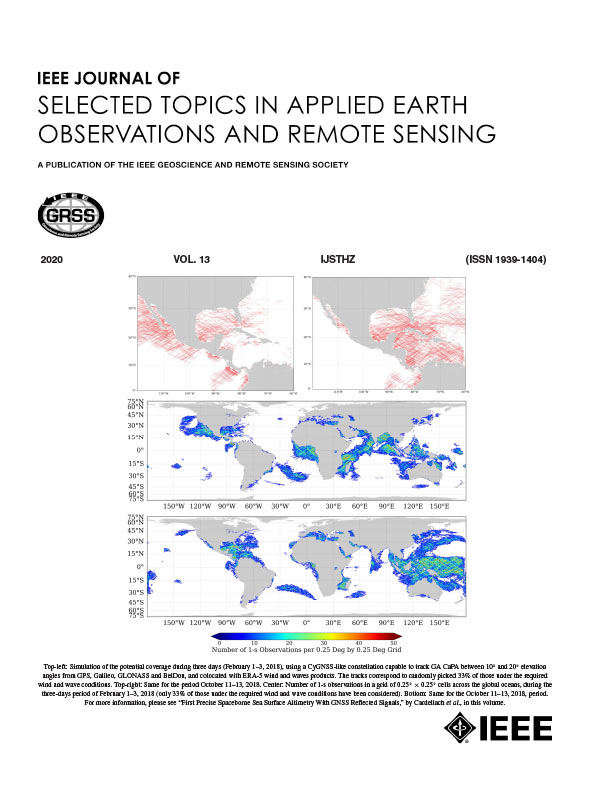Spatiotemporal Dynamic Change and the Driving Mechanism of Desertification in the Yellow River Basin
IF 4.7
2区 地球科学
Q1 ENGINEERING, ELECTRICAL & ELECTRONIC
IEEE Journal of Selected Topics in Applied Earth Observations and Remote Sensing
Pub Date : 2024-09-03
DOI:10.1109/JSTARS.2024.3453295
引用次数: 0
Abstract
The yellow river basin (YRB) plays a crucial role in maintaining national ecological security, and controlling desertification is a critical factor in strengthening the foundation for the high-quality development of the basin. However, there are fewer studies on the spatiotemporal patterns of desertification change in different regions of the YRB, and the mechanisms affecting desertification change are not yet clear. The objective of this article was to construct a desertification difference index (DDI) to characterize the degree of desertification in the YRB based on surface Albedo and normalized difference vegetation index. We analyzed the spatiotemporal patterns of desertification in different regions of the YRB. We used geographical detector and correlation analyses to screen out the main drivers affecting desertification change. We found that the DDI increased significantly at a rate of 0.5 × 10 −3 /a from 2001 to 2021, indicating a slowing down trend of desertification in the YRB. The spatial concentration of desertification was a high degree of agglomeration and significant spatial autocorrelation. Precipitation (PRE) and surface radiation were the primary factors influencing desertification in the YRB. The most important factor influencing desertification in the upstream of the YRB and midstream of the YRB areas was PRE. However, human footprint has exacerbated desertification in the downstream of the YRB. This article aims to reveal the driving mechanisms behind desertification in the YRB. The objective is to provide a reference for combating desertification and improving the ecological environment in the region.黄河流域荒漠化的时空动态变化及其驱动机制
黄河流域在维护国家生态安全中具有举足轻重的作用,治理荒漠化是夯实流域高质量发展基础的关键因素。然而,对黄河流域不同区域荒漠化变化时空格局的研究较少,影响荒漠化变化的机制也不明确。本文旨在基于地表反照率和归一化差异植被指数,构建荒漠化差异指数(DDI),以表征长江流域的荒漠化程度。我们分析了长三角不同地区荒漠化的时空格局。我们利用地理探测器和相关分析筛选出影响荒漠化变化的主要驱动因素。我们发现,2001 年至 2021 年,DDI 以 0.5 × 10-3/a 的速率显著增加,表明长三角地区的荒漠化有减缓的趋势。荒漠化的空间集聚程度高,空间自相关性明显。降水(PRE)和地表辐射是影响长三角地区荒漠化的主要因素。影响长江上游和中游地区荒漠化的最重要因素是降水。然而,人类的足迹加剧了长江下游地区的荒漠化。本文旨在揭示长三角地区荒漠化背后的驱动机制。目的是为该地区防治荒漠化和改善生态环境提供参考。
本文章由计算机程序翻译,如有差异,请以英文原文为准。
求助全文
约1分钟内获得全文
求助全文
来源期刊
CiteScore
9.30
自引率
10.90%
发文量
563
审稿时长
4.7 months
期刊介绍:
The IEEE Journal of Selected Topics in Applied Earth Observations and Remote Sensing addresses the growing field of applications in Earth observations and remote sensing, and also provides a venue for the rapidly expanding special issues that are being sponsored by the IEEE Geosciences and Remote Sensing Society. The journal draws upon the experience of the highly successful “IEEE Transactions on Geoscience and Remote Sensing” and provide a complementary medium for the wide range of topics in applied earth observations. The ‘Applications’ areas encompasses the societal benefit areas of the Global Earth Observations Systems of Systems (GEOSS) program. Through deliberations over two years, ministers from 50 countries agreed to identify nine areas where Earth observation could positively impact the quality of life and health of their respective countries. Some of these are areas not traditionally addressed in the IEEE context. These include biodiversity, health and climate. Yet it is the skill sets of IEEE members, in areas such as observations, communications, computers, signal processing, standards and ocean engineering, that form the technical underpinnings of GEOSS. Thus, the Journal attracts a broad range of interests that serves both present members in new ways and expands the IEEE visibility into new areas.

 求助内容:
求助内容: 应助结果提醒方式:
应助结果提醒方式:


